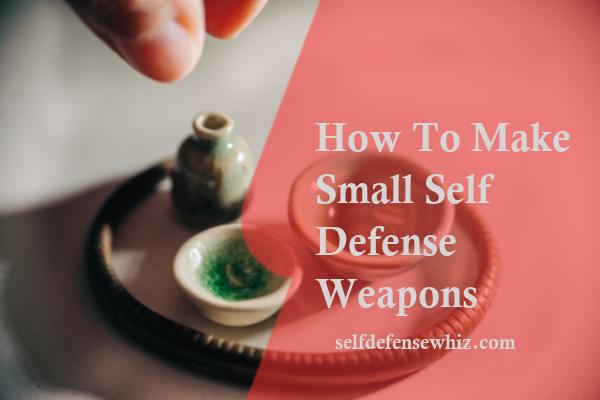How To Make Small Self Defense Weapons
Do you ever worry about your personal safety when you’re out and about? Whether you’re walking alone at night or simply want to feel more prepared in case of an emergency, having a small self-defense weapon can provide extra peace of mind. **In this blog post, we’ll explore some creative and easy ways to make your own small self-defense weapons that you can carry discreetly for added security.** From everyday objects found around your home to simple DIY projects, you’ll discover a variety of options to suit your preferences and ensure you’re always prepared to protect yourself.
How To Make Small Self Defense Weapons
Making small self-defense weapons can be a crucial skill to have in order to increase personal safety and security. Here are some ways to create effective and discreet self-defense tools:
1. Keychain Kubotan: A keychain kubotan is a small, handheld weapon typically made from metal. It can easily be crafted by attaching a metal rod or tube to a keychain. The kubotan is designed to help amplify strikes, applying pressure to sensitive areas of an assailant’s body to immobilize them temporarily. Its compact size and inconspicuous appearance make it an ideal self-defense tool that can be carried everywhere.
2. Paracord Monkey Fist: A monkey fist is a weighted knot tied at one end of a paracord, resembling a small balled fist. It can be formed by inserting a small metal ball or a marble into the knot before it’s tightened. The monkey fist can be swung or used as a striking device, providing an effective means to defend oneself. Additionally, the paracord can be unwound and used in emergency situations, further enhancing its utility.
3. Pen Knife: A pen knife is a versatile and discreet self-defense tool that you can create by modifying an ordinary pen. By removing the ink cartridge and replacing it with a small blade or needle, the pen transforms into a weapon that can be deployed quickly during an attack. Its innocent appearance allows it to be carried in almost any situation without raising suspicion.
It’s important to note that the creation and use of self-defense weapons should always comply with local laws and regulations. Prior knowledge and training on how to effectively use these tools are also essential for personal safety.
Pro-tip: When creating self-defense weapons, consider using reflective materials such as metal or bright colors to increase visibility and potentially deter potential attackers.
Diy
Self-defense is an important skill to possess, especially in situations where one’s safety may be compromised. While there are numerous self-defense weapons available on the market, crafting small, portable weapons for personal protection can be an effective approach. One simple yet effective weapon is a keychain made from paracord. By braiding a length of paracord and attaching a keyring, one can create a discreet weapon that can be easily concealed. This keychain can be used as a whip-like device, capable of inflicting pain and disorienting an attacker.
Another small self-defense weapon that can be crafted is a Kubotan. A Kubotan is a short, cylindrical object typically made from metal or hard plastic. To create a homemade Kubotan, one can use a sturdy pen, or even a dowel rod, and wrap it with paracord for enhanced grip and durability. The Kubotan is designed to target pressure points and can be used for striking or applying leverage techniques to immobilize an attacker. The discreet nature of these small weapons adds to their effectiveness.
Furthermore, a miniaturized personal alarm can be an invaluable self-defense tool. These alarms are small, battery-operated devices that emit a loud and piercing sound when activated. To create a homemade personal alarm, one can repurpose a small electronic device, such as an old mobile phone or key fob, and modify it to emit a similar loud sound. This high-pitched noise can deter potential attackers, attract attention from bystanders, and potentially startle an attacker, providing an opportunity to escape from the situation.
Self-Defense
When it comes to personal safety, it’s important to have some knowledge of self-defense techniques. Having a small self-defense weapon can give you an added sense of security in potentially dangerous situations. One simple and effective option is a keychain self-defense tool. You can purchase or create one by using strong materials such as metal or high-density plastic. These tools typically have a pointed end that can be used to strike an attacker’s sensitive areas. Remember to check your local laws before carrying such a weapon, as they may be restricted in some areas.
Another option is a tactical pen, which is a versatile and discreet self-defense tool. These pens are often made of aircraft-grade aluminum or stainless steel, making them strong and sturdy. They have a sharp end that can be used to deliver a painful strike, and some even come with features like a built-in flashlight or a DNA collector tip. It’s important to practice using this tool properly to ensure effectiveness in a dangerous situation.
Alternatively, a kubotan, a small cylindrical self-defense tool, can be easily carried in your pocket or attached to your keychain. Kubotans are typically made of high-density plastic or metal and have grooves or ridges for a secure grip. By holding it firmly and striking sensitive pressure points on an attacker’s body, a kubotan can incapacitate your assailant, giving you the opportunity to escape safely. Again, familiarize yourself with local laws before possessing and using a kubotan as they might be considered concealed weapons in some jurisdictions.
Small Weapons
The development of small self-defense weapons has gained significant attention in recent years, as people seek to ensure their personal safety in various situations. Creating such weapons requires careful consideration of effectiveness and portability. One option is a discreet personal alarm, which emits a loud sound to attract attention during an attack. These alarms are small, lightweight, and can be easily carried in a pocket or attached to a keychain. They often come with additional features like built-in flashlights or key rings, making them practical tools for self-defense.
Another small and effective self-defense weapon is the tactical pen. Originally designed as a writing instrument, tactical pens are now popular for their additional functionality as improvised self-defense tools. These pens are usually made from sturdy materials such as aircraft-grade aluminum and have sharp, durable tips that can be used for striking or poking an assailant. Some models even include a glass breaker tip, providing an added option for emergency situations, such as escaping from a car accident or other confined spaces.
Furthermore, for those who desire more traditional self-defense options, keychain weapons can be useful. These weapons are typically compact devices made of metal or hard plastic and can be attached to a keychain for easy access. Keychain weapons often feature sharp edges, blunt ends, or pointy tips that can be used to strike or jab an attacker. Their small size allows for discreet carrying, ensuring they are always within reach in potentially dangerous situations.
Homemade
When it comes to personal safety, having a small self-defense weapon can provide a sense of security and peace of mind. It is important to note that these weapons should only be used in situations where self-defense is necessary and legal. One effective option is a kubotan, a small cylindrical tool that can be easily carried on a keychain. To make a kubotan at home, gather a solid metal rod or even a thick pen, around four to six inches long. Smooth out any rough edges and ensure there are no sharp points. You can also add a grip using tape or rubber for better control. Remember, using a kubotan involves targeting sensitive areas of the attacker’s body to disable them temporarily, allowing you to escape safely.
Another self-defense option is a personal alarm, which is a loud noise-making device that can startle and deter potential attackers. Making a homemade personal alarm is simple and requires minimal materials. Obtain a small metal whistle or a small air horn from a sporting goods store. Attach it to a keychain or a lanyard for easy access. To activate the alarm, blow into the whistle or push the button on the air horn. The loud noise will attract attention and discourage an assailant from proceeding further. Personal alarms are legal and non-lethal, making them an excellent choice for self-defense in emergency situations.
Lastly, improvised weapons can be helpful when there are no traditional self-defense tools available. One such option is a tactical pen, which is a sturdy pen designed to double as a weapon. To create a DIY tactical pen, start with a solid metal or heavy-duty plastic pen. Ensure it has a pointed end that can be used to strike an assailant. It’s also beneficial if the pen has a sturdy clip that can be used to grip an attacker or inflict pain. In critical situations, a tactical pen can be a discreet but useful self-defense tool.
Personal Safety
Self-defense is an important aspect of personal safety, and it is always advisable to have some form of protection readily available. There are various small weapons that can be easily made, which can serve as effective self-defense tools. One such example is a homemade keychain self-defense weapon. To make this, start by attaching a small metal rod, such as a nail or a small file, securely to a sturdy keychain. Then, cover the metal rod with a rubber sleeve or a piece of plastic tubing to ensure a comfortable yet firm grip. This small weapon can be easily carried in a pocket or attached to a bag, providing a handy tool that can be used for striking an assailant if necessary.
Another simple self-defense weapon that can be easily made is a pocket-sized pepper spray. To create this, you will need a small spray bottle, preferably with a fine misting nozzle, and some ingredients. Mix water, a small amount of liquid dish soap, and a generous portion of chili powder or crushed red pepper flakes. Transfer the mixture into the spray bottle, making sure it is properly sealed. This homemade pepper spray can be carried in a pocket or a purse, ready to be used against an attacker by spraying it in their face, causing temporary blindness and intense discomfort.
In addition to the above examples, there are other small self-defense weapons that can be created using simple household objects. A rolled-up magazine or newspaper, for instance, can be utilized as an improvised baton, providing a long reach and a sturdy impact surface. Similarly, a common flashlight can be enhanced by attaching a sharp edge or small spikes to be used as a striking tool. However, it is crucial to remember that the primary purpose of these weapons is self-defense, and one should only resort to using them when one’s safety is at immediate risk.
Conclusion
To conclude, making small self-defense weapons can be a practical and empowering skill to develop. By following the steps outlined in this blog, you can create effective and easy-to-use tools to enhance your personal security. Remember, these weapons should be used responsibly and only as a last resort to protect yourself from harm. Whether it’s a simple pocket-sized stun gun or a discreet personal alarm system, it’s important to prioritize your safety and well-being. Additionally, always consult local laws and regulations regarding the possession and use of self-defense weapons in your area. With an understanding of basic self-defense techniques and the ability to craft small weapons, you can feel more confident and secure in navigating the world around you.







